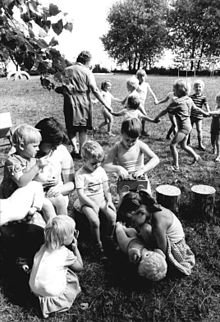Harvest kindergarten


As harvest kindergartens special are kindergartens referred to that offer in rural areas during the busy harvest months, usually from April to October or November, a child care. Harvest kindergartens were set up to support the rural population, especially during the summer and autumn months, in such a way that the mothers of agriculture were available as a full-fledged labor. Harvest kindergartens were widespread, especially during the Nazi era and in the GDR .
history
The institution of the harvest kindergarten has been handed down since the beginning of the 19th century at the latest. The operation of a harvest kindergarten in the Principality of Lippe is recorded for the year 1802 . This was opened by Pauline Christine Wilhelmine zur Lippe , the then regent of the principality. With this facility, she ensured that the farmers' women were fully able to work during the harvest.
After the seizure of power by the National Socialists were throughout the German Reich increasingly established harvest kindergartens. These were controlled and managed by the National Socialist People's Welfare . Contemporary statistics from the NSDAP Reichsleitung record around 450 harvest kindergartens for April 1934, the number of which rose to around 700 by the autumn of that year. After the annexation of Austria , these areas were also provided with numerous such facilities.
After the end of the Second World War and the collapse of National Socialist society, work began on re-establishing the social infrastructure in the former Reich. The model of the harvest kindergarten was also used again from the end of the 1940s. Such institutions have been set up in the Federal Republic and Austria . However, they had a much greater significance and distribution in the GDR. In the decades that followed, most harvest kindergartens were converted into year-round childcare facilities as a result of the development of the educational system.
Others
In the GDR there was a harvest kindergarten as a prefabricated house under the designation type 147 EK 5 / 8.1 , which was produced in the VEB Holzbaukombinat Nord in Stralsund . The building measured about 6.4 meters by 10 meters and cost 7,900 marks . According to the manufacturer, the construction of the prefabricated barracks took 90 hours. In addition to being used as a harvest kindergarten, it was intended to be used as construction site accommodation, as an office or as a sanitary building.
Individual evidence
- ↑ Gisela M. Gary: "We are not aunts!" The kindergarten teacher: on the history of a woman's profession in Austria. Vier-Viertel-Verlag, 2006, ISBN 978-3-902141-22-4 , pp. 193 .
- ↑ Alexander Schleissinger: The Kindergarten and the National Socialists - Effects of the Nazi ideology on public childcare in the years 1933-1945. In: The Kita-Handbuch. Institute for Education and Future Research, accessed on October 13, 2016 .
- ^ Rainer Bookhagen: The Protestant child care and the inner mission in the time of National Socialism . tape 1 . Verlag Vandenhoeck & Ruprecht, Göttingen 1998, ISBN 978-3-525-55729-7 , p. 198 f . ( limited preview in Google Book search).
- ↑ From the “Anschluss” to the “Resettlement”. Documentation archive of the Austrian resistance, accessed on October 13, 2016 .
- ↑ The harvest kindergarten: instructions and material collection for all educators . People and Knowledge Volkseigener Verlag, Berlin 1955.
- ↑ S. Hensel: Handbook construction site equipment: building. Scientific-Technical Center for Industrial Construction (Ed.), Dresden 1971, p. 7, 36.